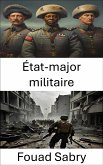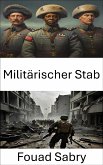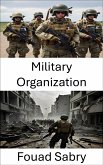What is Military Staff
A military staff or general staff is a group of officers, enlisted and civilian staff who serve the commander of a division or other large military unit in their command and control role through planning, analysis, and information gathering, as well as by relaying, coordinating, and supervising the execution of their plans and orders, especially in case of multiple simultaneous and rapidly changing complex operations. They are organised into functional groups such as administration, logistics, operations, intelligence, training, etc. They provide multi-directional flow of information between a commanding officer, subordinate military units and other stakeholders. A centralised general staff results in tighter top-down control but requires larger staff at headquarters (HQ) and reduces accuracy of orientation of field operations, whereas a decentralised general staff results in enhanced situational focus, personal initiative, speed of localised action, OODA loop, and improved accuracy of orientation.
How you will benefit
(I) Insights, and validations about the following topics:
Chapter 1: Staff (military)
Chapter 2: Bulgarian Armed Forces
Chapter 3: Tatmadaw
Chapter 4: Battalion
Chapter 5: Brigade
Chapter 6: Military Assistance Command
Chapter 7: Indonesian Army
Chapter 8: Strategic Command (United Kingdom)
Chapter 9: Wyoming Military Department
Chapter 10: Home Command (British Army)
(II) Answering the public top questions about military staff.
Who this book is for
Professionals, undergraduate and graduate students, enthusiasts, hobbyists, and those who want to go beyond basic knowledge or information for any kind of Military Staff.
A military staff or general staff is a group of officers, enlisted and civilian staff who serve the commander of a division or other large military unit in their command and control role through planning, analysis, and information gathering, as well as by relaying, coordinating, and supervising the execution of their plans and orders, especially in case of multiple simultaneous and rapidly changing complex operations. They are organised into functional groups such as administration, logistics, operations, intelligence, training, etc. They provide multi-directional flow of information between a commanding officer, subordinate military units and other stakeholders. A centralised general staff results in tighter top-down control but requires larger staff at headquarters (HQ) and reduces accuracy of orientation of field operations, whereas a decentralised general staff results in enhanced situational focus, personal initiative, speed of localised action, OODA loop, and improved accuracy of orientation.
How you will benefit
(I) Insights, and validations about the following topics:
Chapter 1: Staff (military)
Chapter 2: Bulgarian Armed Forces
Chapter 3: Tatmadaw
Chapter 4: Battalion
Chapter 5: Brigade
Chapter 6: Military Assistance Command
Chapter 7: Indonesian Army
Chapter 8: Strategic Command (United Kingdom)
Chapter 9: Wyoming Military Department
Chapter 10: Home Command (British Army)
(II) Answering the public top questions about military staff.
Who this book is for
Professionals, undergraduate and graduate students, enthusiasts, hobbyists, and those who want to go beyond basic knowledge or information for any kind of Military Staff.
Dieser Download kann aus rechtlichen Gründen nur mit Rechnungsadresse in A, B, BG, CY, CZ, D, DK, EW, E, FIN, F, GR, H, IRL, I, LT, L, LR, M, NL, PL, P, R, S, SLO, SK ausgeliefert werden.









